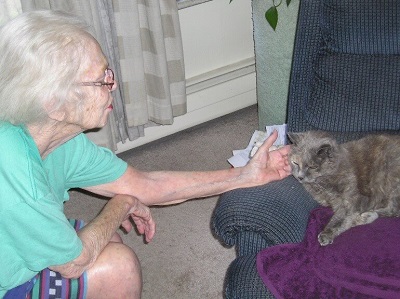 As we navigate our senior years, we may think of having a pet as being a therapy of sorts. And perhaps it is, just as being active and involved in social, educational, civic or religious activities can be viewed as being therapeutic. Or we may just enjoy the loyalty which four-legged companions provide to us. Atul Gawande has written a wonderful book titled “Being Mortal” and there is a section in his book which tells of a nursing home director who brought in cats and dogs and 100 birds, for the benefit of the residents. I will leave the birds to Dr. Gawande, while I focus on dogs and cats in this article. Charlie Brown’s Snoopy taught me as a child that the proper expression is always “Dogs and Cats” rather than “Cats and Dogs.”
As we navigate our senior years, we may think of having a pet as being a therapy of sorts. And perhaps it is, just as being active and involved in social, educational, civic or religious activities can be viewed as being therapeutic. Or we may just enjoy the loyalty which four-legged companions provide to us. Atul Gawande has written a wonderful book titled “Being Mortal” and there is a section in his book which tells of a nursing home director who brought in cats and dogs and 100 birds, for the benefit of the residents. I will leave the birds to Dr. Gawande, while I focus on dogs and cats in this article. Charlie Brown’s Snoopy taught me as a child that the proper expression is always “Dogs and Cats” rather than “Cats and Dogs.”
Reduced Blood Pressure
Many seniors, whether living alone or with a spouse, friend or partner, spend many hours each day alone in their thoughts. When one has lived six, seven, eight or more decades, there are a lot of memories and thoughts for one to reflect upon. Oftentimes, realizing that those memories are long ago and never to be again, raises a senior’s blood pressure. And when one lives alone, high blood pressure brought on by fear, worry and a sedentary lifestyle can induce all sorts of physical and mental health maladies.
A 2018 report published by the National Institutes of Health (NIH) states that “Interacting with animals has been shown to decrease levels of cortisol (a stress-related hormone) and lower blood pressure. Other studies have found that animals can reduce loneliness, increase feelings of social support, and boost your mood.” Having a pet in one’s life creates the important sense of being needed in the life of another creature, be it a four-legged pet or a two legged human.
Reduced Anxiety and Depression
When we reach ages 60+, many find that old friends, and too often family as well, have either disappeared or passed away. For most of us, our identities were tied to our families, employment or careers. Our working years are usually behind us and too often our family is either scattered, busy with their own lives, or no longer alive. I am 61 at the time of this writing. My years of providing caregiving for my Mother, which I wrote about in “Just Before the Stroke of Seven”, are over. It occasionally hits me that I am no longer a son or a grandson. While I do not dwell on such thinking, at times it does cause me feelings of anxiety and/or depressed thinking. This is a natural occurrence with people who reflect on their lives and the ones they have loved.
Having a pet in one’s life provides a connection which can bridge the gap, the loss, the feeling of being all alone. In short, pets interact with us when we might most need it. Having a pet in our lives can help reduce anxiety and depression. A study by the Human Animal Bond Research Institute revealed that 74% of pet owners reported mental health improvements from pet ownership.
Increased Exercise
Fido or Fluffy is at the front door, letting us know that they want to go outside. Cats and dogs can, of course, tend to themselves when allowed free range in our fenced-in back yard. However, putting a leash on our pet and allowing them to take us for a walk allows us to join them in some fresh air and exercise. It also can provide social interaction for us as we will often see neighbors while walking outside. My Mother had osteoarthritis. She found that the pain and stiffness in her fingers and hands was reduced by the simple actions of petting her cats, using her fingers to massage them behind their ears, on their backs and legs. Mom swore by it, and she had cats in her home for many, many years. Her arthritic fingers continued to crochet well into her 70’s.
Walking has proven to boost immune system, ease joint pain, and improve mood. According to the New York Times, Dog owners spent close to 300 minutes each week walking with their dogs, about 200 more minutes of walking than people without dogs. So, not only does having a pet, especially a dog, help reduce anxiety and depression, they also increase the amount you walk, which is great for your health!
Companionship
Being of a different nature than goldfish or turtles, dogs and cats allow for a relationship which is reciprocal in nature. They will sit on our lap, rub up against our legs, rest their head on an arm, and occasionally chew on a favorite pair of sneakers. They also provide us a sense of being needed. Fido and Fluffy cannot operate a can opener when they are hungry. They need us to feed them. They generally enjoy when we brush their fur. Many pet owners will agree that their dogs and cats are acutely aware of the moods of their owners. They can, and do, offer comfort when emotions are raw and sad, or even just pensive. 
Being needed by a beloved pet allowed my Mother to have an added sense of purpose late in her life. Mom had Wernicke’s aphasia and dementia, and Rosie, her cat, had renal (kidney) failure. A couple of times a week, we gave subcutaneous (under the skin) water treatments to Rosie. Mom’s job was to keep Rosie still while I administered the saline. The bond between my Mother and her/our cat was too beautiful for words. After the treatment, Mom would spend some time brushing Rosie’s fur while quietly talking with her. Keep in mind that Mom had severe aphasia, and Rosie was a cat. Those two communicated just fine. I miss them both. I don’t think that Rosie misses those water treatments.
Aaron Ainbinder is the author of “Just Before the Stroke of Seven” which is available on Amazon.


Comments